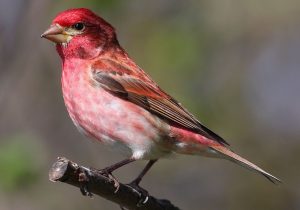“A strong argument for the inhumanity of clear cutting is that we put at risk all animals that are forced into refugee status.” – Soren Bondrup-Nielsen
In a recent post on the NatureNS listserv (a birds and natural history discussion list), Donna Crossland surmised that the lack of purple finches at her bird feeder could be due to loss of older softwood forest from extensive clearcutting in her area:

Male purple finch. Photo by Simon Pierre Barrette (Wikipedia). Is it being impacted by widespread clearcutting on short rotations?
Similar to Marg’s observations, there are no purple finches around, but I have gold finches a plenty. Considering what purple finches consume, I suspect the population will be extra low for a while, aside from its usual irregularities as a winter feeder visitor and its reported declines elsewhere from House finch invasions.
I was observing air photo imagery under DNR’s Harvest Plans Map Viewer a few days ago. It is clear that we are flattening nearly all the remaining mature conifer forest in NS that would have supplied much of the natural sources of seed. With 55 year harvest rotations set up on Crown land, it’s not certain what natural food supply will remain for the next while. Trees need time to mature before producing any significant quantity of seed. It’s a dire situation we are creating for wildlife. Meanwhile, the “field and roadside junco and goldfinch crews” seem perfectly fine.
She invited other thoughts, opposing or otherwise… and received this comment from Soren Bondrup-Nielsen (Professor Emeritus at Acadia University):
I have often had discussions about what happens to wildlife when an area is clear cut. The general notion is that the animals (mobile ones) just leave and settle in adjacent areas and continue living “happily”. Therefore, we can feel good to some extent. However, in most cases, animals robbed of their local habitat face a slow death. If they try to move to adjacent areas there are already individuals living there so there is little to no room for the “refugees”. It is well known that dominance is a function of prior “ownership” and thus new individuals that try to get established are “battered around” and are not allowed to settle and they are thus exposed to predation and will soon die. Thus, a strong argument for the inhumanity of clear cutting is that we put at risk all animals that are forced into refugee status.
Wildlife biologist Bob Bancroft has often talked and written about animals displaced by clearcutting, noting for example that “Trees that grow on clearcuts do not provide as many habitats essential for the survival of the wide variety of animals, plants and lichens found in Acadian forests. Inhabitants displaced by clearcutting rarely, if ever, find new homes nearby. (In Scorched Earth, article in Saltscapes, 2011).
In NOVA SCOTIA NATURALLY: Wealth of fauna call N.S. forests home (CH Sep 12, 2014) Bob provides many specific examples. A few of them:
The fast pace of forest harvests still has warblers, flycatchers and others returning to our province only to find previous nesting and feeding sites gone. Finding unoccupied forest elsewhere is unlikely. Many birds adapted to mature forests seek their food in higher, middle or lower portions of tall-tree canopies. Young forests lack that critical vertical element.
Flying squirrels and many other mammals need standing trees with holes or denning logs on the ground. Moving to a young forest without cavities and old logs is not an option.
Ovenbirds skilfully weave a nest on the ground within large forested areas. It’s important for them to locate it far away from woodland edges that attract prowling skunks, raccoons, foxes, crows, bobcats, house cats and blue jays…Ovenbirds may return to find a forest fragmented by harvesting, with forest edges nearby. They may have to nest near an edge and lose their eggs or nestlings to a plundering predator.Oven bird. Photo by DickDaniels on Wikipedia
Bancroft concludes:
Current partial cut and clearcut harvest methods cause too drastic a change for nature and forest wildlife. The increased sunlight, heat and wind-drying effects on harvested landscapes render them inhospitable for wildlife species that live in forests with mature trees. Thirty- and 40-year cutting rotations are eliminating the older trees needed by wildlife for survival.
Whether or not the lead-in to this post, purple finch, turns out to be one of them, “Refugees” seems a very apt term to describe wildlife that are displaced by clearcutting. It especially applies in Nova Scotia where forest harvesting is amongst the most, if not the most, intensive in Canada (view Post Feb 11, 2017).
For more about birds in Nova Scotia forests, view links under Birds on this website. Also, you can follow the NatureNS discussions without subscribing at NOVA SCOTIA BIRD NEWS BY DATE. They offer some fascinating, seasonally timely observations, and stimulating discussions; Donna’s is just one of them!
——–
Some early followup on Donna Crossland’s post about purple finch on NatureNS:
“Here at our little feeder Donna Purple Finches are the second most common bird I see – after Gold Finches. Red breasted Nuthatches come every once in a while the White Breasted and Brown Creepers stay in the trees…” to which DC responded: “That’s fascinating.. Might I wager a guess that you would have more purple finches because the thin wedge of forests remaining and rimming the Atlantic coast would feature more mature conifer?”. Another comment: “I have lots of Purple finches at my feeder this year. The trends may vary within the region.” To be continued!

